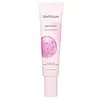What's inside
What's inside
 Key Ingredients
Key Ingredients

 Benefits
Benefits

 Concerns
Concerns

 Ingredients Side-by-side
Ingredients Side-by-side

Water
Skin ConditioningCaprylic/Capric Triglyceride
MaskingButyrospermum Parkii Butter
Skin ConditioningNiacinamide
SmoothingPalmitoyl Tripeptide-5
Skin ConditioningPanthenol
Skin ConditioningSodium Hyaluronate
HumectantGlyceryl Stearate
EmollientGlycerin
HumectantHydroxypropyl Cyclodextrin
MaskingPalmitoyl Tripeptide-38
Skin ConditioningPolyglyceryl-2 Stearate
EmulsifyingStearyl Alcohol
EmollientGlycine Soja Protein
EmulsifyingHydrolyzed Rice Protein
Skin ConditioningSuperoxide Dismutase
AntioxidantAscorbic Acid
AntioxidantSqualane
EmollientCaffeine
Skin ConditioningHesperidin
EmollientGlycyrrhiza Glabra Root Extract
BleachingIsopropyl Palmitate
EmollientArgania Spinosa Kernel Oil
EmollientOpuntia Ficus-Indica Stem Extract
Skin ConditioningMicrocrystalline Cellulose
AbsorbentCellulose Gum
Emulsion StabilisingTocopherol
AntioxidantChamomilla Recutita Flower Extract
MaskingPhenethyl Alcohol
MaskingCaprylyl Glycol
EmollientEthylhexylglycerin
Skin ConditioningPunica Granatum Seed Oil
EmollientXanthan Gum
EmulsifyingCamellia Sinensis Extract
AntioxidantCitrus Aurantifolia Peel Extract
CleansingCeramide NP
Skin ConditioningWater, Caprylic/Capric Triglyceride, Butyrospermum Parkii Butter, Niacinamide, Palmitoyl Tripeptide-5, Panthenol, Sodium Hyaluronate, Glyceryl Stearate, Glycerin, Hydroxypropyl Cyclodextrin, Palmitoyl Tripeptide-38, Polyglyceryl-2 Stearate, Stearyl Alcohol, Glycine Soja Protein, Hydrolyzed Rice Protein, Superoxide Dismutase, Ascorbic Acid, Squalane, Caffeine, Hesperidin, Glycyrrhiza Glabra Root Extract, Isopropyl Palmitate, Argania Spinosa Kernel Oil, Opuntia Ficus-Indica Stem Extract, Microcrystalline Cellulose, Cellulose Gum, Tocopherol, Chamomilla Recutita Flower Extract, Phenethyl Alcohol, Caprylyl Glycol, Ethylhexylglycerin, Punica Granatum Seed Oil, Xanthan Gum, Camellia Sinensis Extract, Citrus Aurantifolia Peel Extract, Ceramide NP
Water
Skin ConditioningC13-15 Alkane
SolventGlycerin
HumectantPEG-100 Stearate
Behenyl Alcohol
EmollientButylene Glycol
HumectantCetyl Ricinoleate
EmollientOlea Europaea Fruit Oil
MaskingNannochloropsis Oculata Extract
HumectantPullulan
Dipeptide-2
Skin ConditioningPalmitoyl Tetrapeptide-7
Skin ConditioningLycium Barbarum Fruit Extract
AstringentArnica Montana Flower Extract
MaskingButyrospermum Parkii Butter
Skin ConditioningSodium Benzoate
MaskingPotassium Sorbate
PreservativeCaprylic/Capric Triglyceride
MaskingTribehenin
EmollientCetyl Alcohol
EmollientSodium Carbomer
Emulsion StabilisingPhenoxyethanol
PreservativeEthylhexylglycerin
Skin ConditioningHesperidin Methyl Chalcone
AntioxidantSteareth-20
CleansingSodium Hyaluronate
HumectantMica
Cosmetic ColorantTitanium Dioxide
Cosmetic ColorantIron Oxides
Caprylyl Glycol
EmollientHydrogenated Lecithin
EmulsifyingWater, C13-15 Alkane, Glycerin, PEG-100 Stearate, Behenyl Alcohol, Butylene Glycol, Cetyl Ricinoleate, Olea Europaea Fruit Oil, Nannochloropsis Oculata Extract, Pullulan, Dipeptide-2, Palmitoyl Tetrapeptide-7, Lycium Barbarum Fruit Extract, Arnica Montana Flower Extract, Butyrospermum Parkii Butter, Sodium Benzoate, Potassium Sorbate, Caprylic/Capric Triglyceride, Tribehenin, Cetyl Alcohol, Sodium Carbomer, Phenoxyethanol, Ethylhexylglycerin, Hesperidin Methyl Chalcone, Steareth-20, Sodium Hyaluronate, Mica, Titanium Dioxide, Iron Oxides, Caprylyl Glycol, Hydrogenated Lecithin
Ingredients Explained
These ingredients are found in both products.
Ingredients higher up in an ingredient list are typically present in a larger amount.
This ingredient is also known as shea butter. It is an effective skin hydrator and emollient.
Emollients help soothe and soften your skin. It does this by creating a protective film on your skin. This barrier helps trap moisture and keeps your skin hydrated. Emollients may be effective at treating dry or itchy skin.
Shea butter is rich in antioxidants. Antioxidants help fight free-radicals, or molecules that may harm the body. It is also full of fatty acids including stearic acid and linoleic acid. These acids help replenish the skin and keep skin moisturized.
While Shea Butter has an SPF rating of about 3-4, it is not a sunscreen replacement.
Shea butter may not be fungal acne safe. We recommend speaking with a professional if you have any concerns.
Learn more about Butyrospermum Parkii ButterThis ingredient is an emollient, solvent, and texture enhancer. It is considered a skin-softener by helping the skin prevent moisture loss.
It helps thicken a product's formula and makes it easier to spread by dissolving clumping compounds.
Caprylic Triglyceride is made by combining glycerin with coconut oil, forming a clear liquid.
While there is an assumption Caprylic Triglyceride can clog pores due to it being derived from coconut oil, there is no research supporting this.
Learn more about Caprylic/Capric TriglycerideCaprylyl Glycol is a humectant and emollient, meaning it attracts and preserves moisture.
It is a common ingredient in many products, especially those designed to hydrate skin. The primary benefits are retaining moisture, skin softening, and promoting a healthy skin barrier.
Though Caprylyl Glycol is an alcohol derived from fatty acids, it is not the kind that can dry out skin.
This ingredient is also used as a preservative to extend the life of products. It has slight antimicrobial properties.
Learn more about Caprylyl GlycolEthylhexylglycerin (we can't pronounce this either) is commonly used as a preservative and skin softener. It is derived from glyceryl.
You might see Ethylhexylglycerin often paired with other preservatives such as phenoxyethanol. Ethylhexylglycerin has been found to increase the effectiveness of these other preservatives.
Glycerin is already naturally found in your skin. It helps moisturize and protect your skin.
A study from 2016 found glycerin to be more effective as a humectant than AHAs and hyaluronic acid.
As a humectant, it helps the skin stay hydrated by pulling moisture to your skin. The low molecular weight of glycerin allows it to pull moisture into the deeper layers of your skin.
Hydrated skin improves your skin barrier; Your skin barrier helps protect against irritants and bacteria.
Glycerin has also been found to have antimicrobial and antiviral properties. Due to these properties, glycerin is often used in wound and burn treatments.
In cosmetics, glycerin is usually derived from plants such as soybean or palm. However, it can also be sourced from animals, such as tallow or animal fat.
This ingredient is organic, colorless, odorless, and non-toxic.
Glycerin is the name for this ingredient in American English. British English uses Glycerol/Glycerine.
Learn more about GlycerinSodium Hyaluronate is hyaluronic acid's salt form. It is commonly derived from the sodium salt of hyaluronic acid.
Like hyaluronic acid, it is great at holding water and acts as a humectant. This makes it a great skin hydrating ingredient.
Sodium Hyaluronate is naturally occurring in our bodies and is mostly found in eye fluid and joints.
These are some other common types of Hyaluronic Acid:
Learn more about Sodium HyaluronateWater. It's the most common cosmetic ingredient of all. You'll usually see it at the top of ingredient lists, meaning that it makes up the largest part of the product.
So why is it so popular? Water most often acts as a solvent - this means that it helps dissolve other ingredients into the formulation.
You'll also recognize water as that liquid we all need to stay alive. If you see this, drink a glass of water. Stay hydrated!
Learn more about Water